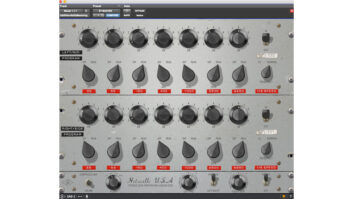
Evanescence is one of the hottest new bands to come out in a longtime, especially with Grammy Awards for Best New Artist and Best HardRock Performance. After seeing the show at San Jose’s Event Center inNorthern California, we left impressed by both singer Amy Lee’sextensive vocal range and the prospect that this band has a long careerahead of them. Mix spoke with the band’s front-of-house andmonitor engineers about the tour.
Front-of-house Engineer Eddie “Muscles” Mapp works on aMidas XL4 with Clair’s i4 line array (10 i4s and eight Prism subs perside). “Clair’s iO system helps keep everything consistent fromvenue to venue,” Mapp says. “The i4s can be a little harshup top, but with the iOs in-line, it’s never been a problem.
“We’ve been using several of Audio-Technica’s new Artist EliteSeries mics, including the AE2500 dual-diaphragm kick mic and the 5000Series wireless with the 5400 mic. We tried a few combinations of micsthroughout this tour and I’ve found the 2500 seems to give the biggestimpact. It’s shock-mounted internally just off the batter head, andbrings out everything that’s been missing from the kick without the useof separate microphones.

“Evanescence is primarily an in-ear band,” Monitorengineer Joshua Swart reports. “The recent addition of TerryBalsemo to the band brought the element of stage volume back since he’sa wedge guy. Thanks to the advice of [Saliva monitor engineer] KevinGoode, I now use downward expanders on several instruments to keep themout of the way until it’s their turn to be heard. I love the downwardexpander for vocals, so whenever Amy’s not right on the mic, guitarsand drums will stay where they belong in her ears without just bleedingthrough her mic and mudding up her mix. It also works great for wedgesand fills, so when she’s jumping around and the mic is swinging around,I don’t have to worry about feedback because her mic level has jumpeddown 6 to 10 dB. Expanders work great on overheads, rides and hi-hats.You won’t see me going back out without a rack of dbx 166XLs or dbx1066s.
“I also use Shure’s DFR 22 for her vocal. I split her vocalfor ears and wedges. On the signal going to the wedge, I insert theDFR.
“I use a Midas H3000 and it is the best-sounding analogconsole out there. The mic pre’s and EQs make everyone’s job easier.The H3000’s routing leaves it flexible to do both ears and wedgessimultaneously, and keeps my ear mixes away from my cue wedges, andvice versa. I love the Shure PSM 600 wireless transmitters andreceivers. Although there are some frequency limitations, they justsound amazing and stereo separation is great.
“I use a Pro Tools|HD3 system to run all of our loops,strings, choir, background vocals and other little noises that we havegoing on. We actually took the original tracks and orchestra tracks andmixed them down for use with the live shows.”
“Keeping Amy Lee’s vocal out front is definitelyimportant,” says Mapp. With her vocal ranging from a faintwhisper to soaring falsettos, Josh and I always pay careful attentionto mic rejection. Since we began using the A-T 5400, we’ve noticed adrastic improvement: The vocals are much smoother and other problems(such as cymbal bleed) are nearly nonexistent. The use of the 5400along with the i4 has allowed me to reduce my signal path out front toa BSS 901-II and a dbx 160SL. I use the 901 to help withintelligibility in her lower midrange during softer sections due toproximity effect and the 160SL to ensure that she stays on top of themix throughout the night. Combined, it’s a pretty efficient package,but still carries enough weight to let everyone know that we werehere.”




